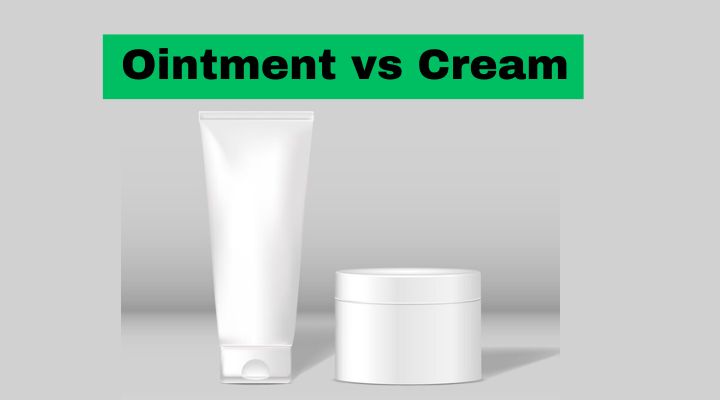Ointments and creams are both topical formulations used in dermatology and pharmacy for a variety of purposes, although they differ significantly in composition and properties:
1. Composition:
- Ointments: Ointments are semi-solid preparations that consist of a base that is usually an oil or petroleum jelly. They are heavily oily and may contain little or no water.
- Creams: Creams are also semi-solid, but they have a lower oil content compared to ointments. Creams typically have a water-based or aqueous component along with oils or fats.
2. Texture:
- Ointments: Ointments have a greasy and thick texture. They tend to be more occlusive and provide a barrier on the skin.
- Creams: Creams have a smoother and lighter texture. They are easier to spread and absorb into the skin, leaving less of a greasy residue compared to ointments.
3. Moisturizing vs. Occlusive:
- Ointments: Ointments are often preferred for their occlusive properties, which means they create a protective layer on the skin, preventing moisture loss. They are good for dry or damaged skin.
- Creams: Creams are more hydrating and are absorbed more readily by the skin. They can be applied to hydrate and address different skin problems.
4. Medication Delivery:
- Ointments: Ointments are ideal for delivering medications to the skin when a prolonged release or high potency is required. Topical steroids, antibiotics, and antifungal drugs are frequently applied with them.
- Creams: Creams are commonly used for medications that need to be absorbed relatively quickly into the skin, as they allow for better penetration of active ingredients.
5. Skin Type:
- Ointments: Ointments are often recommended for people with very dry or sensitive skin, as they provide a strong protective barrier.
- Creams: Creams are suitable for a wider range of skin types and are generally more user-friendly due to their lighter texture.
6. Shelf Life:
- Ointments: Compared to creams, ointments often have a longer shelf life. Ointments’ occlusive properties aid in maintaining the stability of their active ingredients over time.
- Creams: Due to their water content, which can encourage microbial development and lessen product stability, creams may have a lower shelf life.
7. Consistency:
- Ointments: Ointments are excellent for use in adverse weather situations since they maintain their consistency despite temperature fluctuations.
- Creams: Creams’ texture and effectiveness might be impacted by hot temperatures since they can thin down or separate.
8. Packaging:
- Ointments: Ointments are frequently packed in jars or tubes because to their thicker consistency, which prevents them from being used with pump dispensers.
- Creams: Creams are frequently sold in squeeze tubes or pump dispensers, making them more practical.
The particular skin disease being treated, the preferred texture, and the therapeutic objectives all influence the decision between an ointment and a cream. Based on the patient’s needs and the prescribed medication, pharmacists and medical professionals frequently suggest the best formulation.
Author Bio – Meet the experts behind All Cure Remedies a trusted third-party pharmaceutical ointment manufacturer based in India. We take pleasure in creating top-notch ointment formulations that address a range of healthcare demands with a dedication to quality and innovation. Our team of skilled professionals works diligently to offer superior products that ensure the welfare of our clients and their customers.



